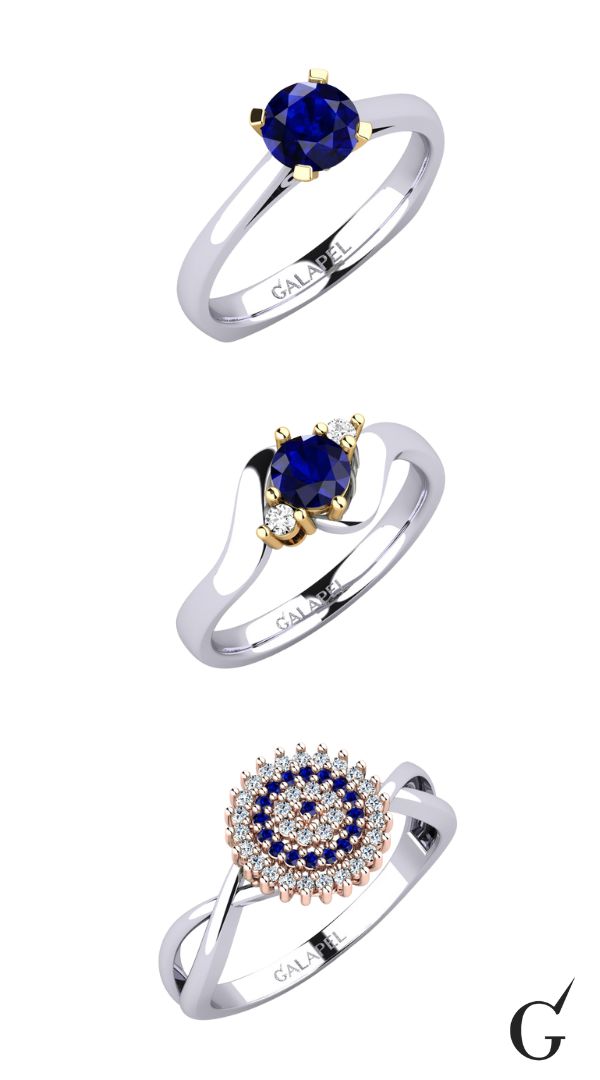Sapphire Stones: Nature's Blue, Historical Depths, and the Art of Jewelry
Sapphire stands as one of nature's most captivating gems. Yet, the value of this precious stone isn't limited to its aesthetic allure; it also boasts a rich history, profound symbolism, and a significant place in the jewelry industry.
Contents
- 1. Chemical and Natural Structure of Sapphire
- 2. Characteristics of the Corundum Mineral
- 3. Chemical Foundations of Color Formation
- 4. Natural Diversity of Sapphire
- 5. Sapphire Through History and Its Legends
- 6. Sapphire's Place in Ancient Times
- 7. Royalties and the Significance of Sapphire
- 8. Sapphire and Wisdom
- 9. Ancient Persians and the Sky Legend
- 10. Origins of Sapphire
- 11. Geographical Distribution of Sapphire
- 12. Star Sapphire: Nature's Unique Gift
- 13. Myanmar and the "Royal Blue" Sapphire
- 14. Thailand's Sapphire Mining
- 15. Formation and Geological Structure of Sapphire
- 16. Daily Use and Care
- 17. Sapphire's Color Diversity: Blue, White, Pink, and Yellow
- 18. Sapphire's Place in the Art of Jewelry
- 19. Historical Importance of Sapphire
- 20. Aesthetic Value: Dance of Colors
- 21. Durability and Longevity
- 22. Bearer of Symbolic Meanings
- 23. Conclusion
1. Chemical and Natural Structure of Sapphire
 Sapphire is among nature's most mesmerizing gems. Beyond its aesthetic appeal, it possesses a rich chemical composition and natural formation. This unique structure grants sapphire a special place in the global jewelry sector.
Sapphire is among nature's most mesmerizing gems. Beyond its aesthetic appeal, it possesses a rich chemical composition and natural formation. This unique structure grants sapphire a special place in the global jewelry sector.
Sapphire's unique chemical composition, natural formation, and industrial uses make it a truly exceptional gemstone.
2. Characteristics of the Corundum Mineral
Sapphire is a form of the mineral corundum, based on aluminum oxide. Corundum is a widely occurring mineral in nature, renowned for its hardness. In fact, it's recognized as the second hardest natural substance known, following diamond. This hardness is one of the primary reasons sapphire is favored in the jewelry industry.
Corundum's remarkable hardness and various colors found in nature contribute to its significance in both jewelry and industry.
3. Chemical Foundations of Color Formation
The color palette of sapphire varies depending on the trace elements it contains. Specifically, iron and titanium are the trace elements responsible for sapphire's characteristic blue hue. These elements, when integrated into the corundum crystal structure, produce a blue color. However, the color palette of sapphire isn't limited to blue. For instance, the presence of the trace element chromium can result in pink or red sapphires. Yellow and green sapphires, on the other hand, derive their colors from the presence of iron.
4. Natural Diversity of Sapphire
Sapphires can be found in a plethora of colors in nature. This color diversity stems from sapphires being exposed to different trace elements in various geographical regions worldwide. This showcases both the diversity and richness of sapphire. For instance, sapphires mined in Sri Lanka are typically blue, while those extracted in Australia might be green or yellow.
Understanding the chemical and natural structure of sapphire helps us better grasp why this precious stone is so valued.
5. Sapphire Through History and Its Legends
Throughout history, sapphires have been celebrated for their beauty and significance. This section delves into the historical importance of sapphire and the legends surrounding it.
6. Sapphire's Place in Ancient Times
Sapphire's presence in ancient civilizations is a testament to its timeless appeal. Learn about how sapphire was used in ancient jewelry and artifacts.
7. Royalties and the Significance of Sapphire
Sapphire's deep blue color has long been associated with royalty and nobility. Explore the historical significance of sapphire in royal jewelry.
8. Sapphire and Wisdom
In various cultures, sapphire has been linked to wisdom and spirituality. Discover the symbolic meanings of sapphire related to wisdom.
9. Ancient Persians and the Sky Legend
The ancient Persians believed that the Earth rested on a giant sapphire, creating the blue sky. Learn more about this fascinating legend.
10. Origins of Sapphire
Delve into the geological origins of sapphire and the conditions required for its formation deep within the Earth.
11. Geographical Distribution of Sapphire
Explore the regions around the world where sapphire is mined and learn about their unique sapphire deposits.
12. Star Sapphire: Nature's Unique Gift
Discover the mesmerizing optical effect of star sapphires and how they get their distinctive asterism.
13. Myanmar and the "Royal Blue" Sapphire
Myanmar is renowned for its exceptional "royal blue" sapphires. Learn about the significance of Burmese sapphires in the global market.
14. Thailand's Sapphire Mining
Thailand plays a vital role in the global sapphire industry. Explore the sapphire mining practices and trade in Thailand.
15. Formation and Geological Structure of Sapphire
Learn about the geological processes that lead to the formation of sapphire and its unique geological characteristics.
16. Daily Use and Care
Discover how to properly wear and care for sapphire jewelry to ensure its longevity and lustrous appearance.
17. Sapphire's Color Diversity: Blue, White, Pink, and Yellow
Explore the array of colors found in sapphires and the factors that influence their hues, from blue to white, pink, and yellow.
18. Sapphire's Place in the Art of Jewelry
Learn how sapphire has been used in various types of jewelry, from engagement rings to pendants, and its role in contemporary designs.
19. Historical Importance of Sapphire
Uncover the historical significance of sapphire in various cultures and its representation in art and literature.
20. Aesthetic Value: Dance of Colors
Explore the aesthetic value of sapphires, including the captivating visual effects and the dance of colors they exhibit.
21. Durability and Longevity
Learn about sapphire's exceptional durability and why it's a top choice for jewelry that lasts a lifetime.
22. Bearer of Symbolic Meanings
Discover the symbolic meanings attributed to sapphires in various cultures, from love and loyalty to truth and faithfulness.
23. Conclusion
Sum up the key takeaways from this exploration of sapphire, from its chemical structure and natural diversity to its historical and symbolic significance.











